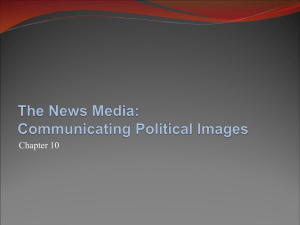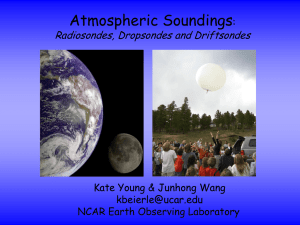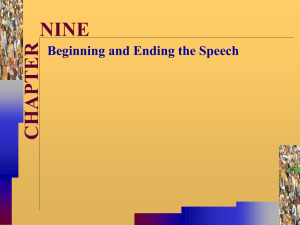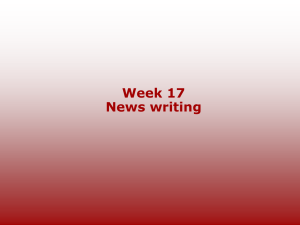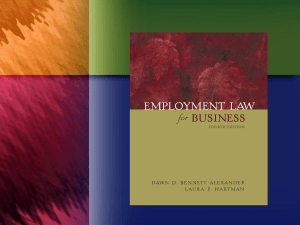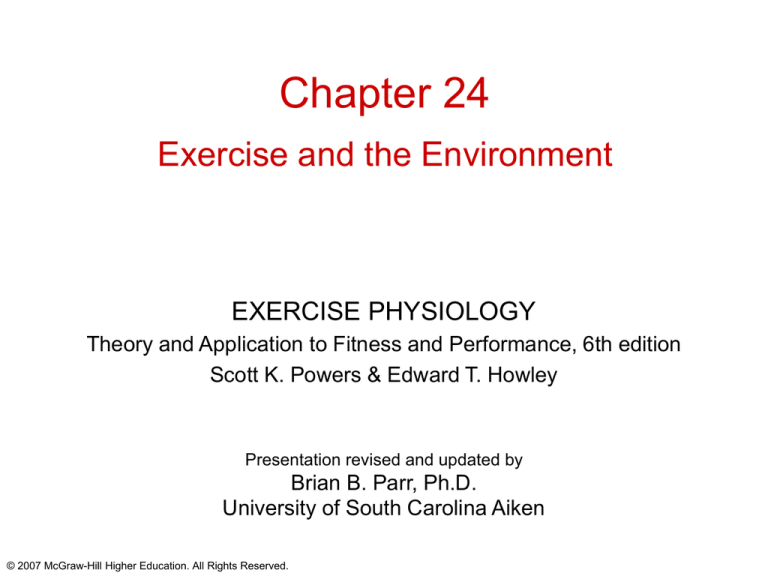
Chapter 24
Exercise and the Environment
EXERCISE PHYSIOLOGY
Theory and Application to Fitness and Performance, 6th edition
Scott K. Powers & Edward T. Howley
Presentation revised and updated by
Brian B. Parr, Ph.D.
University of South Carolina Aiken
© 2007 McGraw-Hill Higher Education. All Rights Reserved.
Objectives
1. Describe the changes in atmospheric pressure, air
temperature, and air density with increasing altitude.
2. Describe how altitude affects sprint performances
and explain why that is the case.
3. Explain why distance running performance
decreases at altitude.
4. Draw a graph to show effect of altitude on VO2 max
and list the reasons for this response.
5. Graphically describe effect of altitude on the heart
rate and ventilation responses to submaximal work,
and explain why these changes are appropriate.
© 2007 McGraw-Hill Higher Education. All Rights Reserved.
Objectives
6. Describe the process of adaptation to altitude, and
the degree to which this adaptation can be
complete.
7. Explain why such variability exists among athletes in
the decrease in VO2 max upon exposure to altitude,
the degree of improvement in VO2 max at altitude,
and the gains made upon return to sea level.
8. Describe potential problems associated with training
at high altitude and how one might deal with them.
9. Explain the circumstances that caused physiologists
to reevaluate their conclusions that humans could
not climb Mount Everest without oxygen.
© 2007 McGraw-Hill Higher Education. All Rights Reserved.
Objectives
10. Explain the role that hyperventilation plays in helping
to maintain a high oxygen-hemoglobin saturation at
extreme altitudes.
11. List and describe the factors influencing the risk of
heat injury.
12. Provide suggestions for the fitness participant to
follow to minimize the likelihood of heat injury.
13. Describe in general terms the guidelines suggested
for running road races in the heat.
14. Describe the three elements in the heat stress index,
and explain why one is more important than the
other two.
© 2007 McGraw-Hill Higher Education. All Rights Reserved.
Objectives
15. List the factors influencing hypothermia.
16. Explain what the wind chill index is relative to heat
loss.
17. Explain why exposure to cold water is more
dangerous than exposure to air of the same
temperature.
18. Describe what the “clo” unit is and how
recommendations for insulation change when one
does exercise.
© 2007 McGraw-Hill Higher Education. All Rights Reserved.
Objectives
19. Describe the role of subcutaneous fat and energy
production in the development of hypothermia.
20. List the steps to follow to deal with hypothermia.
21. Explain how carbon monoxide can influence
performance, and list the steps that should be taken
to reduce the impact of pollution on performance.
© 2007 McGraw-Hill Higher Education. All Rights Reserved.
Altitude
Atmospheric pressure
– Decreases at higher altitude
Partial pressure
– Same percentages of O2, CO2, and N2 in the air
– Lower partial pressure of O2, CO2, and N2
– Hypoxia:
• Low PO2 (altitude)
– Normoxia:
• Normal PO2 (sea level)
– Hyperoxia:
• High PO2
© 2007 McGraw-Hill Higher Education. All Rights Reserved.
Effect of Altitude on Performance
Short-term anaerobic performance
– Lower PO2 at altitude should have no effect of
performance
• O2 transport to muscle does not limit performance
– Lower air resistance may improve performance
Long-term aerobic performance
– Lower PO2 results in poorer aerobic performance
• Dependent of oxygen delivery to muscle
Comparison of performances
– 1964 Olympics in Tokyo
– 1968 Olympics in Mexico City
© 2007 McGraw-Hill Higher Education. All Rights Reserved.
Short Races: 1964 and 1968 Olympics
© 2007 McGraw-Hill Higher Education. All Rights Reserved.
Table 24.1
Long Races: 1964 and 1968 Olympics
© 2007 McGraw-Hill Higher Education. All Rights Reserved.
Table 24.2
Maximal Aerobic Power and Altitude
Decreased VO2max at higher altitude
Up to moderate altitudes (~4,000m)
– Decreased VO2max due to decreased arterial PO2
At higher elevations
– VO2max reduction also due to fall in maximum
cardiac output
• Decreased maximal HR at altitude
© 2007 McGraw-Hill Higher Education. All Rights Reserved.
Changes in VO2 Max With Increasing
Altitude
© 2007 McGraw-Hill Higher Education. All Rights Reserved.
Figure 24.1
Effect of Altitude on Submaximal Exercise
Elicits higher heart rate
– Due to lower oxygen content of arterial blood
Requires higher ventilation
– Due to reduction in number of O2 molecules per
liter of air
© 2007 McGraw-Hill Higher Education. All Rights Reserved.
Effect of Altitude on the Heart Rate
Response to Submaximal Exercise
© 2007 McGraw-Hill Higher Education. All Rights Reserved.
Figure 24.2
Effect of Altitude on the Ventilation
Response to Submaximal Exercise
© 2007 McGraw-Hill Higher Education. All Rights Reserved.
Figure 24.3
Adaptation to High Altitude
Production of more red blood cells
– Via erythropoietin (EPO)
– Counters desaturation caused by lower PO2
Lifetime altitude residents
– Have complete adaptations in arterial oxygen
content and VO2max
In those recently arriving at altitude
– Adaptations are less complete
© 2007 McGraw-Hill Higher Education. All Rights Reserved.
Training for Competition at Altitude
Effect of training at altitude on VO2max varies among
athletes
– Due to degree of saturation of hemoglobin
Some athletes can improve VO2max by training at
altitude, others cannot
– May be due to training state before arriving at
altitude
Some athletes have higher VO2max upon return to low
altitude, while others do not
– Could be due to “detraining” effect
• Cannot train as intensely at altitude
© 2007 McGraw-Hill Higher Education. All Rights Reserved.
Live High, Train Low
Live at high altitude
– Elicit an increase in red blood cell mass
Train at low altitude
– Maintain high interval training velocity
– Some athletes still experience hemoglobin
desaturation
• May limit interval training velocity
Some debate between “live high, train low” and “train
high, live low” approaches
© 2007 McGraw-Hill Higher Education. All Rights Reserved.
The Quest for Everest
Mount Everest was first successfully climbed in 1953
– Using supplemental oxygen
Climbed without oxygen in 1978
– Previously thought this would be impossible
• VO2max at summit would be just above rest
– Actually, VO2max estimated at 15 ml•kg-1•min-1
• Due to miscalculation of barometric pressure at summit
© 2007 McGraw-Hill Higher Education. All Rights Reserved.
The Highest Altitudes Attained by
Climbers in the 20th Century
© 2007 McGraw-Hill Higher Education. All Rights Reserved.
Figure 24.4
Maximal Oxygen Uptake Measured at a
Variety of Altitudes
© 2007 McGraw-Hill Higher Education. All Rights Reserved.
Figure 24.5
Challenges of High Altitude Climbing
Successful climbers have great capacity for
hyperventilation
– Drives down PCO2 and H+ in blood
– Allows more O2 to bind with hemoglobin at same
PO2
Climbers must contend with loss of appetite
– Results in weight loss and muscle fiber diameter
Lactate paradox
– Higher lactate response to exercise higher at
altitude (acute)
– Lactate levels lower with chronic altitude exposure
• Due to lower plasma catecholamine levels
© 2007 McGraw-Hill Higher Education. All Rights Reserved.
Heat
Hyperthermia
– Elevated body temperature
Heat-related problems
– Heat syncope
– Heat cramps
– Heat exhaustion
• May require medical attention
– Heat stroke
• Medical emergency
© 2007 McGraw-Hill Higher Education. All Rights Reserved.
Heat-Related Problems
© 2007 McGraw-Hill Higher Education. All Rights Reserved.
Table 24.3
Factors Affecting Heat Injury
© 2007 McGraw-Hill Higher Education. All Rights Reserved.
Figure 24.6
Effect of Different Types of Uniforms on
Body Temperature
© 2007 McGraw-Hill Higher Education. All Rights Reserved.
Figure 24.7
Implications for Fitness
Know signs/symptoms of heat illness
Exercise in cooler part of the day
Gradually increase exposure to heat/humidity to
acclimatize
Drink water before, during, and after exercise
Wear light clothing
Monitor HR and alter exercise intensity
– Stay within target heart rate zone
© 2007 McGraw-Hill Higher Education. All Rights Reserved.
Implications for Performance
Emphasis on pre-season conditioning
– Improve fitness and promote acclimatization
Safety during events in high heat/humidity
– Cooler time of day, season of the year
– Frequent water stops
• Encourage drinking of 150–300 ml water every 15
minutes
– Identification of those with heat illness
– Coordinate proper treatment
• First aid, ambulance services, hospitals
– Competitor education
• Provide information about heat illness
© 2007 McGraw-Hill Higher Education. All Rights Reserved.
Environmental Heat Stress
Wet bulb globe temperature (WBGT)
– Dry bulb temperature (Tdb)
• Air temperature in shade
– Black globe temperature (Tg)
• Radiant heat load in direct sunlight
– Wet bulb temperature (Twb)
• Index of ability to wick sweat
• Most important in determining overall heat stress
WBGT = 0.7Twb + 0.2Tg + 0.1Tdb
Risk of heat stress depends on WBGT
© 2007 McGraw-Hill Higher Education. All Rights Reserved.
Cold
Hypothermia
– Heat loss exceeds heat production
• Conduction, convection, radiation, evaporation
Important to protect against heat loss
– Maintain core temperature
© 2007 McGraw-Hill Higher Education. All Rights Reserved.
Environmental Factors
Temperature
– Gradient for convective heat loss
Vapor pressure
– Low water vapor pressure encourages
evaporation
Wind
– Rate of heat loss influenced by wind speed
– Windchill index
• “Effective” temperature
Water immersion
– Rate of heat loss 25x greater than air of same
temperature
© 2007 McGraw-Hill Higher Education. All Rights Reserved.
Wind Chill Chart
© 2007 McGraw-Hill Higher Education. All Rights Reserved.
Table 24.4
Insulating Factors
Subcutaneous fat
– Especially effective in cold water
Clothing
– Clo units
• 1 clo is insulation needed to maintain core temperature at
rest at 21°C, 50% RH, and 6 m•min-1 wind
• Increased clothing required in cold, wet, windy conditions
• Dry clothing more effective than wet
Amount of insulation required is lower during exercise
© 2007 McGraw-Hill Higher Education. All Rights Reserved.
Energy Production
Energy production increases upon exposure to cold
– Inverse relationship between VO2 and body
fatness
• Earlier onset of shivering in lean men
• Resting VO2 and core temperature maintained in “fat”
men in cold water
• Increased VO2 and decreased core temperature in “thin”
men
- Lower decrease in core temperature with exercise
Women cool faster than men
– Longer delay in shivering and lower VO2
© 2007 McGraw-Hill Higher Education. All Rights Reserved.
Factors Affecting Hypothermia
© 2007 McGraw-Hill Higher Education. All Rights Reserved.
Figure 24.8
Effect of Water Temperature on Survival
© 2007 McGraw-Hill Higher Education. All Rights Reserved.
Figure 24.9
Changes in Insulation Requirement at
Different Temperatures and Activities
© 2007 McGraw-Hill Higher Education. All Rights Reserved.
Figure 24.10
Dealing with Hypothermia
Effects of hypothermia
– Reduced coordination
– Slurred speech
– Impaired judgment
Treatment of hypothermia
– Get person out of cold, wind, and rain
– Remove all wet clothing
– Provide warm drinks and dry clothing
– Put person into sleeping bag
• With another person, if semiconscious
– Find a source of heat
© 2007 McGraw-Hill Higher Education. All Rights Reserved.
Air Pollution
Variety of gases and particulates
Have detrimental effect on health and performance
– Decrease capacity to transport oxygen
– Increase airway resistance
– Altering perception of effort
Physiological response depends on:
– Amount or “dose” received
• Concentration in air
• Duration of exposure
• Volume of air inhaled
- Increases during exercise
© 2007 McGraw-Hill Higher Education. All Rights Reserved.
Air Pollution
Particulate matter
– Microscopic and submicroscopic particles
Ozone
– Decreases VO2max and respiratory function
Sulfur dioxide
– Causes bronchoconstriction in asthmatics
Carbon monoxide
– Binds to hemoglobin and reduces oxygen
transport
– Affects submaximal exercise and VO2max
© 2007 McGraw-Hill Higher Education. All Rights Reserved.
Preventing Air Pollution Problems
Reduce exposure time
– Effects are dose-dependent
Stay away from “bolus” amounts of pollutants
– Smoking areas, high-traffic areas, urban areas
Do not exercise during most polluted parts of day
– 7–10 am, 4–7 am
Monitor the air quality index (AQI)
– Measure of five pollutants
• Ozone, particulate matter, CO, SO2, and NO2
– AQI scale runs from 0–500
• 0–50 is “good;” 151–200 is “unhealthy”
© 2007 McGraw-Hill Higher Education. All Rights Reserved.
Effect of Carbon Monoxide on VO2 Max
© 2007 McGraw-Hill Higher Education. All Rights Reserved.
Figure 24.11


